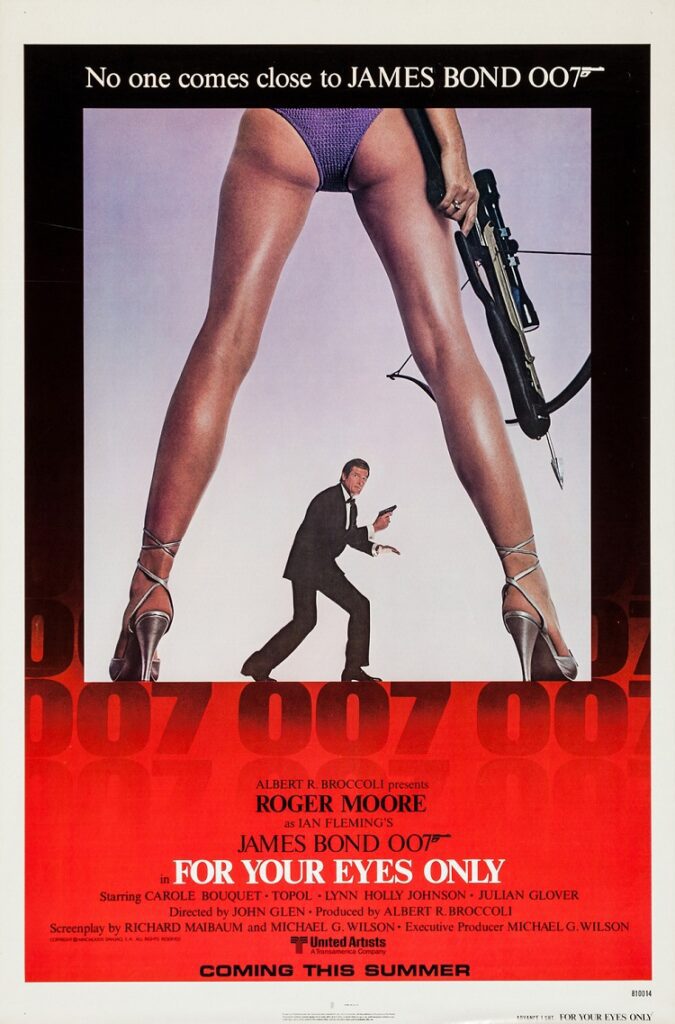
Written by Michael Nazarewycz
For Your Eyes Only (1981) marks the twelfth installment in the James Bond franchise, and the fifth to star Roger Moore as 007. After the space-romp that was Moonraker, the series came back to earth…or maybe “fell back to earth” is more like it. The film is certainly grittier and more realistic (relatively speaking) than past Moore-as-Bond films, but in its quest to abandon the gadgetry that helped make Bond famous, it instead relies on gimmickry that rings untrue.
The film opens with Bond at the grave of his late wife (see On Her Majesty’s Secret Service), setting a somber tone. He is whisked from the cemetery via helicopter for what he believes to be an emergency. When the pilot is remotely executed, Bond learns that the helicopter is being operated via remote control by his arch nemesis, Bloefeld.
(It’s important to note that we never see Bloefeld’s face, nor is his name mentioned, but the wheelchair-bound bald baddie can be no other.) Bond manages to gain control of the helicopter, and he uses the skid to hook Bloefeld’s chair. Shortly thereafter, Bond drops Bloefeld down a tall smokestack, finally ending the life of the villain. As the story goes, there was a legal battle over the rights to the Bleofeld character, and the producers wanted to put an end to his appearance. While it may have tied a loose end left in Diamonds Are Forever, the sequence itself plays rather cheesily, with Bond patting Bloefeld on the head during flight, and Bloefeld offering Bond a bribe of a delicatessen to put him down.
The title credits mark the first time that a performer appears in the credits – in this case, Scotland’s Sheena Easton, who had a nice run on the U.S. charts during the 1980s, not only with this tune, but with other Top 40 hits both pre- and post-Prince influence.
As for the main plot of the film, it centers on the recovery of the Automatic Targeting and Attack Communicator (ATAC), which was part of a British spy vessel that was sunk when an old mine was accidentally hauled to the surface by a fishing net. The ATAC was critical to communicate with the Royal Navy’s Polaris submarines.
Sir Timothy Havelock (Jack Hedley), an MI6 agent and marine archaeologist, is murdered by a hitman while looking for the ATAC, and Bond is dispatched to find who hired the killer. Before he can, though, the hitman is murdered by Havelock’s daughter, Melina (Carole Bouquet). Bond first suspects Greek smuggler Miles Columbo (Topol), but it turns out that Greek businessman and informant Kristatos (Julian Glover) is the culprit, looking to recover the ATAC for the Soviets.
I have several problems with this film, the first of which is the Bill Conti score. During the action sequences, the score gives each sequence a very ’70s cop show vibe, but in that self-aware way that you think the actors are in on the joke. Perhaps this is why, during the over-long ski chase, I kept waiting for someone to appear with a roll of Mentos.
Next, while I can overlook the fact that this ultimate spy relied far too much on the crossbow-toting Melina, I cannot dismiss that a talking parrot happened to hear the right thing at the right time, and recite that very thing just as Bond needs the information. Again with the TV cop show reference, the inclusion of the parrot to help the secret agent was a very Hart to Hart move.
Quick stream-of-consciousness note: in a fairly tense underwater scene, look for shots and moods the filmmakers clearly lifted from Jaws, right down to the music.
The bad guys are pedestrian at best. I’m not saying the main antagonist needs be Goldfinger every time, but the villains could have been a little more menacing if they weren’t going to be over-the-top. I would have loved a Hans Gruber-type of villain (Die Hard), but instead the baddies are nothing more than cookie-cutter extras.
Next is the appearance of Lynn-Holly Johnson, in the role of Bibi Dahl, an annoying Olympic figure skating hopeful who is sponsored by Kristatos. Johnson, coming off the popularity of 1978’s Ice Castles, could skate in real life, but her inclusion does absolutely nothing to further the film. Even when 20th Century Fox pulled this stunt with Sonja Henie in the 1930s-1940s, they at least built a plot around the skating star and then featured her in skating numbers. Here, Johnson shows that she can skate a little, but again, does nothing to advance the plot. Even Bond was forced to rebuff her advances because of her age.
As for Bond himself, in the producers’ quest to make Bond grittier, they also neutered him significantly in a couple of areas. For starters, there are no gadgets. Gadgets are what make Bond, well, Bond. Desmond Llewelyn makes his usual brief appearance as Q, but the stroll through his lab is rather dull, and Bond is only there to pick up a new car and try to use the fancy new computer to identify a suspect. Also, Bond is relatively tame, sexually speaking. He has an encounter with one woman he meets, but the scene seems forced – almost as if the producers though, “Hmm. We should probably have had a sex scene by now. This is James Bond we’re talking about.” Bond also beds Melina at the end of the film.
I’ve always considered the later Moore films – post-The Spy Who Loved Me – to be the “Dark Ages of Bond” and my consideration is reaffirmed with this revisitation. This certainly isn’t the worst film of the franchise, but it hasn’t held up well over 30 years.
Operation: BOND will return with Octopussy.